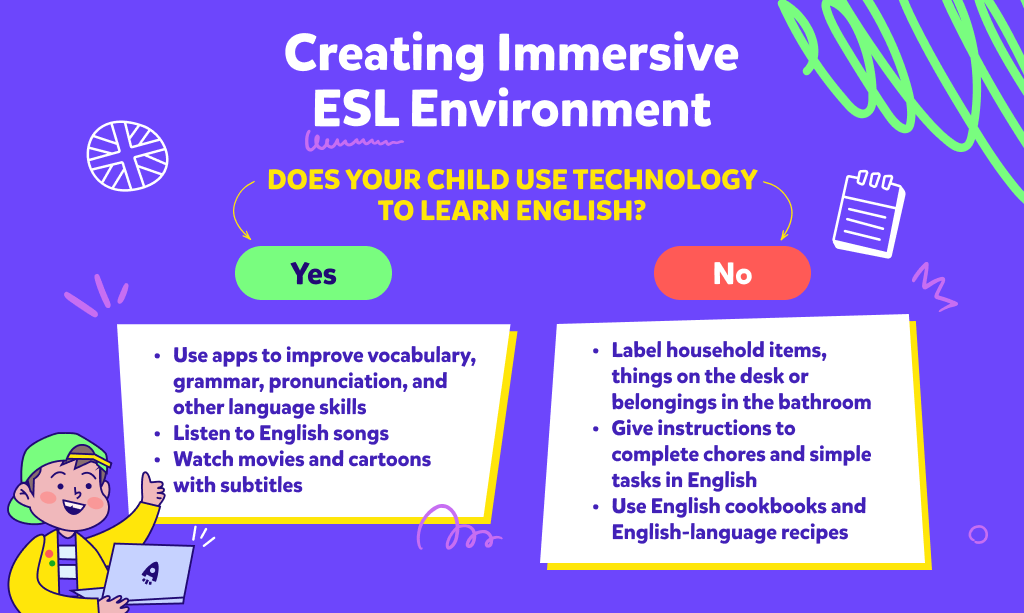- Setting Up a Language-Rich Environment
- Incorporating English into Daily Activities
- Using Technology and Media
- Engaging in Conversational Practice
- Encouraging Consistent Practice
Discover practical strategies to create an immersive ESL environment at home, enhancing language learning through daily activities, technology, and consistent practice. Transform your household into an English learning space with practical tips and techniques.
Ever thought about making your home a place where English learning happens naturally? Imagine waking up and diving into English while you have breakfast, chat in the kitchen, or even sing along to your favorite songs. Turning your home into an ESL playground is all about adding a dash of language-learning fun to your everyday routines.
What if cooking together could also mean learning new words? Or singing along to songs could help improve your pronunciation? With a bit of creativity, your home can become a place where English is not just studied but lived.
And guess what? This isn’t just for kids—it’s for everyone in the family. From watching movies with English subtitles to hosting themed dinners where you practice different situations, there are tons of ways to make English part of your daily life.
In this article, we’ll discuss the six easiest ways to create an immersive ESL environment at home and make learning fun for everyone. Let’s get started!
Setting Up a Language-Rich Environment
Creating an immersive ESL environment at home begins with setting up a language-rich atmosphere. This approach aims to surround you with English language stimuli, making it a natural part of your daily environment.
Labeling Items
Labeling everyday household items with English words is a simple yet effective way to do this. By placing labels on objects such as furniture, appliances, and kitchen items, you associate English words with tangible objects, reinforcing vocabulary retention and facilitating word-object association.
List of Ways to Implement Labeling Items
Labeling Household Items: Attach adhesive labels with English words to objects throughout your home. For example, label the refrigerator, table, chairs, and other furniture items.
Labeling Kitchen Items: Label kitchen utensils, appliances, and food items with their English names. This encourages you to engage with English while cooking or preparing meals.
Labeling Bathroom Items: Label bathroom items such as the sink, bathtub, mirror, and toiletries to reinforce vocabulary related to personal care and hygiene.
Labeling Bedroom Items: Label items in the bedroom, such as the bed, wardrobe, lamp, and alarm clock, to familiarize you with bedroom vocabulary.
Labeling Office or Study Space: If applicable, label items in the home office or study area, such as the desk, computer, books, and stationery, to create an English-rich learning environment for focused study sessions.

Incorporating English into Daily Activities
Next, try to incorporate English into your daily activities. Incorporating This involves weaving language learning into everyday routines and tasks to help capitalize on the frequency and consistency of daily activities.
List of Ways to Implement Incorporating English into Daily Activities
Morning Routine: Start the day with English conversations and media. Encourage family members to greet each other in English, discuss plans for the day, and listen to
English-language music or podcasts during breakfast or while getting ready.
Cooking and Recipes: Use English cookbooks and follow recipes in English. When cooking meals or baking treats, refer to English-language recipes to learn new vocabulary related to ingredients, cooking techniques, and kitchen utensils.
Chores and Tasks: Give instructions and complete tasks in English. Whether it’s doing laundry, cleaning the house, or organizing belongings, use English commands and labels to guide family members through household chores and tasks.
Family Activities: Engage in English-language activities as a family. Play board games, watch movies, or read books together in English to create opportunities for shared language learning experiences and bonding.
Outdoor Exploration: Explore the outdoors while practicing English. Take walks, visit parks, or go on nature hikes, and use English to describe the sights, sounds, and experiences encountered along the way.
Using Technology and Media
Creating an immersive ESL environment at home can also be achieved by strategically using technology and media. This method taps into digital resources available to enhance language learning in engaging and interactive ways. This approach harnesses the benefits of educational apps, multimedia content, and online platforms to provide learners with immersive language experiences.
Ways to Implement Using Technology and Media
Educational Apps: Utilize ESL learning apps and online resources. Explore language learning apps designed to improve vocabulary, grammar, pronunciation, and other language skills through interactive exercises, games, quizzes, and lessons.
TV Shows and Movies: Watch English-language programs with subtitles. Choose TV shows, movies, and documentaries in English and enable subtitles to aid comprehension and reinforce language skills while enjoying entertainment.
Music and Podcasts: Listen to English songs and podcasts. Discover English-language music across various genres and explore podcasts on topics of interest to engage with authentic language content and improve listening skills.
Online Videos and Tutorials: Access online videos and tutorials for language learning. Watch instructional videos, tutorials, and educational content in English on platforms like YouTube to supplement learning and explore new topics and concepts.
Interactive Websites and Games: Engage with interactive websites and games for language practice. Visit websites offering language-learning activities, interactive exercises, quizzes, and games to reinforce vocabulary.
Engaging in Conversational Practice
Engaging in conversational practice helps you develop speaking and listening skills, build confidence in using English, and become more proficient communicators in real-life situations. This also creates an immersive environment at home, as you will be living in a bilingual household to an extent. Engaging in conversational practice focuses on promoting active communication in English through various activities and interactions, such as:
Family Involvement: Encourage family members to participate in English conversations. Engage in daily discussions, share stories, or play language games together as a family to create opportunities for practicing English in a supportive and familiar environment.
Conversation Circles: Organize or participate in conversation circles or discussion groups. Create a regular schedule for gathering with friends, classmates, or community members to engage in English conversations, share experiences, and exchange ideas on different topics of interest.
Online Communities: Join online language communities or forums for English learners. Participate in online discussions, forums, or social media groups dedicated to language learning to interact with other learners.
Encouraging Consistent Practice
Finally, creating an immersive learning environment at home encourages consistent practice, which is key to language skill development. To do this, set a regular schedule for ESL activities to integrate language learning into daily routines. Designate specific times for studying English, practicing speaking or listening skills, and engaging in language-related activities.
Next, implement a rewards system to incentivize progress and achievement. Set achievable milestones or goals for language proficiency and offer rewards such as stickers, certificates, or small treats for reaching each milestone.
Lastly, encourage and celebrate progress to maintain motivation and build confidence. Offer praise, encouragement, and constructive feedback to acknowledge efforts and accomplishments. And always remember to celebrate achievements, no matter how small!
As you can see, turning your home into an immersive ESL environment is both doable and fulfilling. By following the tips in this article, like using labels, setting a daily routine, giving rewards, and cheering on progress, families can make learning English at home exciting and effective. With commitment and imagination, everyone can enjoy the journey of language learning right from the comfort of home!







































